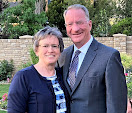The following essay recently won the the Ricks College/Brigham Young University Alumni "Legacy" Writing contest. Enjoy!
Darrel L. Hammon
When students return from BYU-Idaho, I ask them a simple question: “During your stay at BYU-Idaho, did you climb the stoic Menan Buttes?” For the most part, they say no and have a puzzled look on their faces as if to say, “Menan Buttes? What are those?” From my perspective, this is where the spirit of Ricks College/BYU-Idaho emerged for me.
Growing up in the shadows of the Menan Buttes in Menan, Idaho, we did a fair amount of hiking the Buttes, first as children with my parents on Easter weekend and later with friends, fellow Boy Scouts, and my 9th grade class led by Charles Henry, the venerable science teacher at Midway Junior High School. When we arrived at the magical dating age and then post-mission, we took our dates to the Buttes, usually on a full-moon night, flash lights in hand, and hiked to Red Rock on the North Butte. There we sat side by side or back to back, stared down into the valley below and listened to cock pheasants crow and the Black Angus cows on Miller’s place beller. From the top, we could see all the way to Rexburg, yes, even to the “college on the hill.”
It was on this butte, an old volcano, now dormant for thousands of years, where I contemplated life, contemplated what I needed to do, what college I should attend, how I was going to serve a mission, how to get along with my family, and what I generally was going to do with my life. When I sat on the red rock that we fondly called Table Rock or Red Rock, staring into the ancient crater or around the Snake River Valley, I saw beyond the mundane, beyond my own self. Perhaps, it was a place where quietness reigned supreme, despite the wind jostling the cedars, the barking coyotes, the quiet rustling of jack rabbits and mice, and sometimes tractors trudging down dirt roads or through potato fields just below us.
When I returned to BYU-Idaho much later when my daughters attended Especially for Youth, I stood on the new plaza, just south of the Manwaring Center, amazed at the number of students sauntering to and from the new buildings to the north, amazed at the changes, amazed at the new gifts the students received by merely walking the hallowed halls of that great campus. I wondered, though, if they had been to the Buttes, contemplated their lives, wondered about what they were about.
The spirit of Ricks is always seeing afar off and understanding—finally—our roles in both the “small picture” and the “big picture.” At Ricks, it was much like sitting on Red Rock and seeing eastern Idaho, our little world, for the first time or climbing down into the volcano, seeing ragged outcroppings of rock or sagebrush. In class or in devotionals, we learned about the whole person, who you were, what you were about, why you were you, and what you needed to do to become better.
During one class period, we learned about biology and life from Brother Speth; the next period, Brother Stubbs helped us find our way through the Book of Mormon and its many machinations; then the next class, we played playing basketball on “big boys’ court” in the Hart Gymnasium; and to top it off, on Tuesdays, we listened to the servants of God, like President Kimball, who shared with us their lives, their spiritual experiences, their renditions of their own Menan Buttes and understanding themselves for the first time.
Where else can you learn about both academics and yourself, except at Ricks College, now BYU-Idaho? Much like the Menan Buttes, poking out of the good farming country, BYU-Idaho sits on the opposite hill across the great valley and the mighty Snake River, reveling in beauty, academic prowess, and spiritual enlightenment. Is it no wonder that President Hinckley chose “the hill” on which to build a temple of God?
I suspect that if I were to sit on the top of Red Rock today, I would be able to see the expanded lights on the campus and the soft glow of the Rexburg Idaho Temple, feel of its spirit, understand who I was then and what I have become, and hear the gentle, wise voice of the old volcano, whispering across the valley to the temple: “It is your turn to help the young to see afar off” and then retreat to take its ancient place where it had been for thousands of years—overlooking “the college on the hill,” watching another legacy to grow.
Subscribe to:
Post Comments (Atom)










1 comment:
I am so proud of you for winning this award for your story. Way to kick that BYU-I guys' butt!
Post a Comment